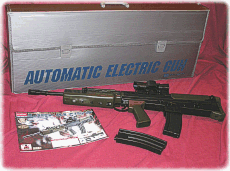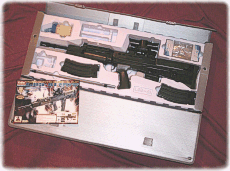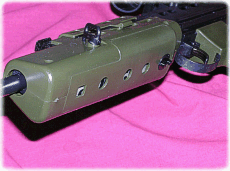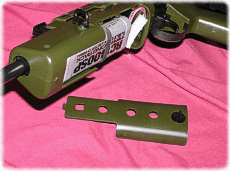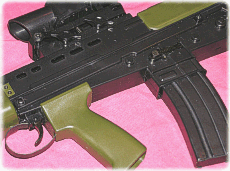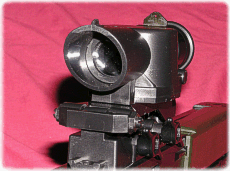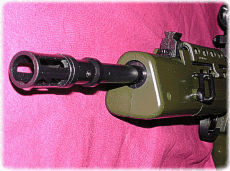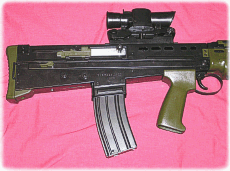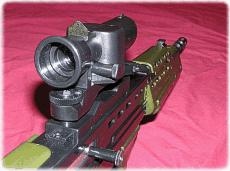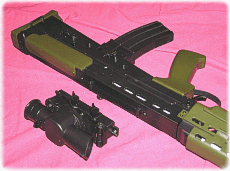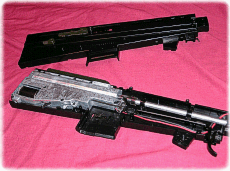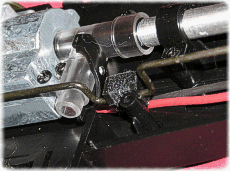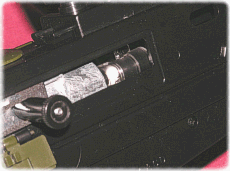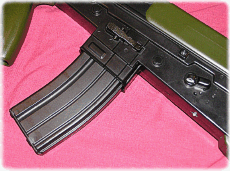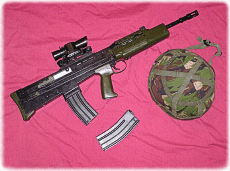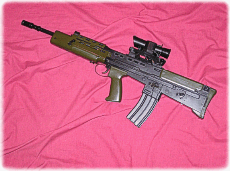Introduction: I’ve recently noticed that an increasing number of airsofters seem keen on an authentic military look to their guns and kit. Due to the popularity of Armalite type guns, and the high quality of kit such as that sold by BHI, I’ve noticed that many Brit’s seem to have begun to be influenced by units from the American armed forces. There’s nothing wrong with that but, having seen the proliferation of “American” troops on British airsoft fields, I decided to see how easy it’d be to get some authentic British airsoft kit together. Top of the shopping list, of course, was an SA80 of some sort. Being under the impression that the Academy L85 was long-dead, I was considering buying an SA80 springer and transplanting P90 internals into it. However, I recently saw Airsoft Scotland showing the Academy L85 as being in stock and the price was very reasonable for an AEG. I should also note that their website was very honest in its description of the L85, suggesting that it wasn’t too terrific in standard form but had great potential after some simple upgrades. Given the price, and the fact that it would make the construction of a decent L85 AEG much simpler, I decided to order one. I removed the gun from the box and began to inspect it more carefully. I have to say that there is nothing about the gun that really strikes me as being cheap and nasty. It just looks, well, like a normal airsoft gun. If you’re used to full-metal AEGs then you might be disappointed by lack of weight and the plastic finish but anybody who has only ever used a Tokyo Marui gun will find nothing obviously sub-standard about it. People often complain about the shiny black plastic receiver. I don’t see a problem with this. Real L85 receivers were painted gloss black so the finish on the Academy gun is actually quite realistic. The only thing that obviously gives the L85 away as an airsoft gun is the battery compartment built into the bottom of the fore-end. I’m not sure why Academy didn’t design the gun so that the battery could be inserted via the hatch in the top of the fore-end. Overall, the gun feels sturdy. It doesn’t creak or rattle at all although certain things begin to give away the cheap construction of the gun. The flash-hider is plastic and is held in place with a rather large Philips screw. The SUSAT is rather cheap looking and there are quite a few recessed holes visible where self-tapping screws hold various parts of the gun together. I also noticed that the front and rear sling loops are made of plastic. It would be preferable if these were made of metal. The gun has a safety-catch above the trigger which works independently of the fire selector switch. The fire selector, which has safe, semi and full-auto settings, can be found on the left-hand side of the gun at the rear. Opposite the fire-selector, on the right-hand side of the gun, there is a fake bolt-release lever. Above this there is a moveable, but non-functional, charging handle which causes the ejection cover to spring down when cycled. One clever feature of the gun is that the hop-up assembly is molded from transparent plastic so, with the charging handle pulled back, it is possible to check if a BB is loaded. This comes in handy because the gun has a habit of holding a BB in the breech, even with the magazine removed. The magazine release lever can be found on the left-hand side of the receiver, above the mag-well. The mag-release lever stands a long way proud of the receiver and is just as prone to causing accidentally dropped magazines as the real gun. Finally, behind the mag-well, on the underside of the receiver, there is a tiny lever which allows the user to decompress the spring. Of all the exterior parts, only the trigger, trigger guard, trigger-safety and magazine release lever are made of metal. I’m not sure I can properly express just how “normal” this gun looks. I was expecting it to feel horribly cheap, poorly made, rather flimsy and with obvious flaws. In fact it has none of these things. It is solid, accurately constructed and the plastic is a reasonable quality, with only a few molding marks visible. Shooting Before shooting the gun a battery must be fitted. There is a rather large black fastener which must be turned to unlock the battery compartment. The instruction book recommends the use of a 7.2v battery and I used one from an r/c car. A normal 8.4v large battery would also fit although I couldn’t guarantee that the Academy gearbox internals could withstand the extra load without damage. There is a heavy duty rubber band inside the battery compartment and you should slide the battery underneath this. Basically, this stops the weight of the battery from resting on the battery cover which is rather flimsy. The fuse, should you ever need access to it, can be found under the top hatch in the fore-grip, which simply pulls open. I took a magazine and the loading rod out of the box next. I filled the loading rod with BBs and tried to push them into the magazine. This was when I had my first clue as to how undeveloped airsoft was at the time when Academy designed the L85. It seems that the loading tube is made out of tubing which is about 10mm diameter. Rather than pressing down into the magazine, the BBs simply form a zig-zag column inside the tube and jam there. I would advise any new owners of this gun to throw away the Academy loading tube straight away. It is infuriatingly useless. After binning the loading rod I used my TM speed-loader and quickly had 30 BBs inserted in the magazine. I noticed, after loading the magazine, the seams of the mag had started to come apart very slightly. It appears that the mag is a simple sandwich construction and, when the spring is compressed, it begins to push the two halves apart slightly. This isn’t a big problem. It is simply another indication that the gun was designed in an age when details were not as important as they are today. The magazine, being plastic, fits with a rather dull click. It is, however, surprisingly solid once in place. Peering through the SUSAT, my target looked like it was about 30m away and the red dot appeared large enough to obscure the target entirely. I aimed as best as I could and fired a few shots in semi-auto. Upon inspection, most of the shots had hit the target but with no real grouping or accuracy. For my next attempt I used the iron sights built into the top of the SUSAT. The iron sights are truly tiny, however, and the sight picture is very small. Another ten shots in semi-auto showed good grouping although none were anywhere near the bullseye. The gun has a fixed hop-up so the only solution is to adjust the SUSAT to try to improve accuracy. Unfortunately, the construction of the SUSAT mount is rather flimsy. The mount of the real SUSAT was always considered complex but, due to accurate construction, works well. Unfortunately, the Academy version is poorly constructed and the SUSAT wobbles rather alarmingly. If I planned to use the replica SUSAT in standard form I would be tempted to glue the joints of the mount, after zeroing the scope, to try to make the sight more solid. All of the controls for the SUSAT are fake except for the large elevation dial on the mount, which I adjusted to improve the accuracy. There is no way to adjust for windage. After adjusting the sights I switched the gun to full-auto and emptied the magazine into the target. The rate of fire is surprisingly good and the magazine was empty in a couple of seconds. It’s worth noting that the magazine always empties faultlessly, which is more than sometimes can be said for other, more expensive, guns. In full-auto the gun actually managed better groups than in semi-auto. I assume this is because the shots follow each other before I moved and altered the point of aim. I reloaded with a fresh magazine and emptied it into a new target. The results were similar and, with subsequent magazines, I always found that far tighter groups were achieved by emptying an entire magazine in full-auto rather than using short bursts or single shots. At this point it’s worth mentioning the balance of the gun. Being a bullpup, the L85 has the gearbox fitted right at the rear of the receiver. This means that the guns centre of gravity is well to the rear. This is most apparent when changing the magazine. When I took my hand off the fore-grip to remove the mag’, I actually found it quite hard to hold the gun level with only my right hand holding the pistol grip. After a couple of hours use the feeling subsides a bit but returns for the first few minutes every time I use the gun. The gun is very comfortable to shoulder or to carry but can be a little clumsy to pick up or handle in other ways. Although the sights are rather poor I found that the gun almost always hit a 6” square target at a range of 10 metres. I don’t think that there are any real problems with the gun being inaccurate. It’s simply that the standard sights aren’t capable of any great accuracy. The fixed hop-up seems to produce a fairly flat trajectory with the 0.2g BBs that I was using. I should note that the 0.12g BBs which were supplied with the gun were never used although they seem to be decent quality. Overall, accuracy is reasonable. The unstable mount is probably responsible for most of the inaccurate shots. It’s possible to simply push the SUSAT and cause it to move by at least 5mm. Also, because the iron sights are mounted on top of the SUSAT, the iron sights are not much more accurate than the scope. Finally, I fired a few shots through my chronograph and found that 0.2g BBs fired at a speed of around 165ft/sec. This equates to a power of around 0.3J. Not terribly powerful but surprisingly useful in practical terms. I’d say this gun would manage a useful range of 25m without too many problems, even with the standard sights. Throughout my test-firing of the gun I was listening for any strange or dubious sounds from the gearbox but heard nothing out of the ordinary. The spring inside the gun is very weak, however, so I don’t imagine that the standard gearbox is under much stress at all. Once again, I found myself surprised by just how well the gun performed, even if the sights are a little bit sub-standard. Technical I bought the Academy L85 with the specific purpose of upgrading it into a first rate AEG. It’s difficult to discuss the standard AEG without considering upgrades I either have made or intend to make. There is no way to field-strip the gun so I had to dismantle the gun into it’s components in order to upgrade the gearbox. I was pleasantly surprised to see that the gearbox seems to be pretty well-made. The metal is finished rather poorly and it is held together with self-tapping screws (as well as a single anti-tamper rivet) but it seems to be strong, accurately machined and comes with metal bushes. The gears seem of decent quality although my usual test (scratching one with a scriber) showed that they aren’t terribly hard. The piston, itself seems to be good quality and the cylinder has no vents because the barrel is so long. The barrel is incredibly long, at roughly 490mm. That’s 140mm longer than the barrel of an M4, even though the gun is very slightly shorter. The gearbox, hop-up, and barrel are all built into the left-hand side of the gun. The front section of the barrel is shrouded in a plastic box-section support. This isn’t very pretty but is functional, does a good job of holding that long barrel securely and is hidden by the fore-grip when the gun is assembled. One problem with the internal mechanism, which required immediate repair, was the trigger linkage. This is constructed in two sections which join with a plastic sleeve. The plastic sleeve is rather weak and easily breaks. I found that after a couple of hours of use it had already split along one side. I repaired this by binding the sleeve with cotton and then dabbing super-glue over the repair, basically the same procedure that a fisherman uses to bind an eye to a new rod. The gun, itself, seems reasonably accurate but is badly let down by the sights. The optical SUSAT sight is functional but very toy-like and the iron sights, since they’re mounted on top of the SUSAT, are also prone to inaccuracy caused by the mounts being rather flimsy. To be honest, sorting out the problems with the SUSAT will probably be more challenging that upgrading the gun itself. At the very least, I would suggest dismantling the sight unit, removing the lenses and rebuilding it with clear, flat, polycarbonate in place of the lenses. Personally, I would consider buying a cheap red-dot sight and fitting it inside the SUSAT shell for a better sight picture. Even with those modifications, however, the SUSAT mounts are terribly flimsy and not very good for accuracy. To be honest, I suspect that I will fit a weaver rail to the receiver of my L85 and use it with a normal red-dot sight while I consider what I can do with the SUSAT to improve its performance. The final hurdle facing owners of the Academy L85 is the magazines. The real SA80 fits STANAG magazines so the gun should take M16 magazines. Unfortunately this isn’t the case. The designers of the Academy L85 must have misjudged the dimensions slightly and the result is that the L85 magazines are slightly smaller than Armalite ones, meaning that M16 magazines are too large to fit the L85 without modification. It should be possible, however, to enlarge the L85 mag-well slightly so that the M16 mag’s will fit. The mag-release slot is in the same place on L85 and M16 mag’s so, once the mag-well has been enlarged, standard M16 mag’s should fit easily. Alternatively, genuine L85 magazines are, apparently, available from Hong-Kong suppliers. Personally, I’d rather modify the gun to suit M16 magazines so that I can share ammo with team-mates. At the risk of labouring the point, the gun is badly let down by the sights. This is made worse because it’s not possible to remove the SUSAT and replace it with another RDS without some modification to the gun, however the gun, itself, is adequate as standard. You really could just buy this gun and use it for skirmishing without any modification. If you decide to upgrade the gun then it should be fairly straightforward to fit TM gears and a suitable spring, spring-guide and hop-up and it would be the equal of most guns currently available. Beyond that, the odd sized magazines stop the gun from being truly practical. The owner is left with the choice of either adapting the gun to suit standard M16 magazines or attempting to buy a number of Academy mag’s. The gun is definitely strong enough to stand up to the punishment of a skirmish and it looks good too. Upgrade the Academy L85 with a few parts from a TM FA-MAS and you’ll have a gun which will be the ultimate “sleeper”. It would be very easy to create a stunning custom gun to be proud of by using this gun as a base for the project. The only thing that lets the gun down, and really deserves to be upgraded at the same time as the rest of the gun, is the sights. I am in the process of upgrading my L85 right now and I will submit the finished gun for Arnie's Projects section.
External links: TBA Last modified: Tuesday, January 11, 2005 0:21 AM Copyright ArniesAirsoft |
